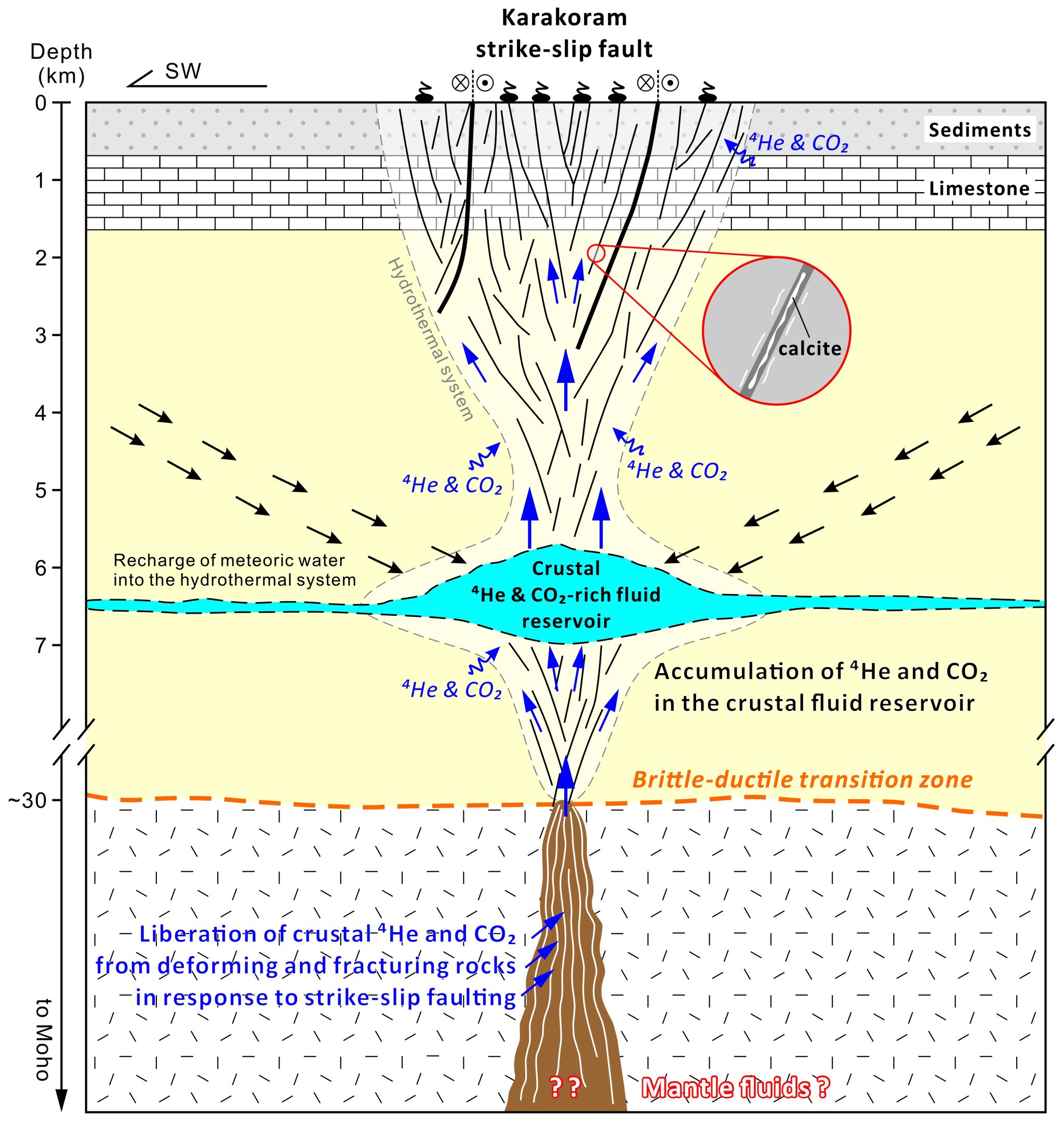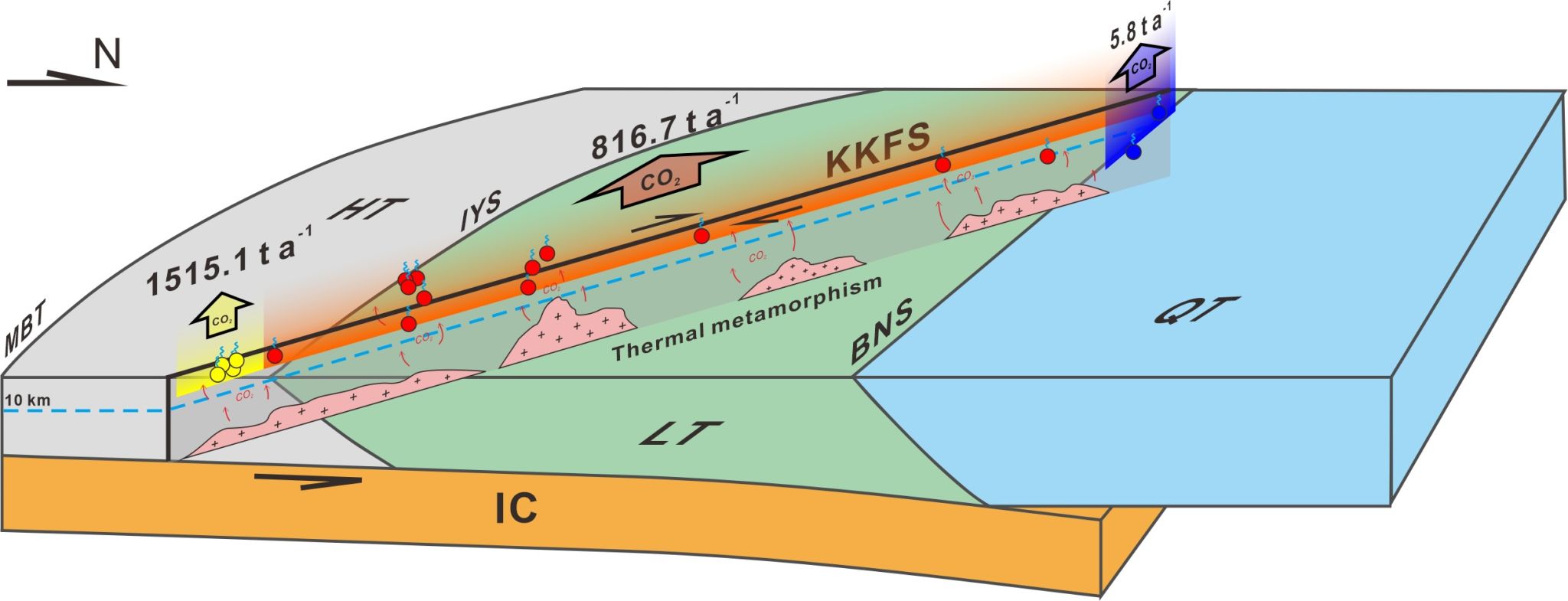Large-scale strike-slip faults are important tectonic boundaries that regulate plate collision and convergence, orogenic plateau uplift, and lateral expansion. They commonly show characteristics of deep-cutting fault planes, strong shear deformation, and rupture, providing favorable channels for groundwater circulation and the release of deeply-sourced fluids to form hydrothermal activities such as hot/boiling springs and geysers at the surface. Previous studies on typical strike-slip faults worldwide, such as the San Andreas fault (USA), the North Anatolia fault (Turkey), and the Alpine fault (New Zealand), show that carbon-bearing fluids from the mantle can be released to the surface through deep-cutting strike-slip fault systems, which represents an important way of mantle carbon emissions. However, does the strike-slip fault generally release mantle-derived fluids? What is the geological significance of carbon-bearing fluids released by strike-slip faults? What is the deep CO2 flux of strike-slip faults?
To answer the above questions, Professor Sheng Xu’s group from the School of Earth System Science at Tianjin University and their collaborators focus on the Karakoram dextral strike-slip fault in the western part of the Tibetan Plateau and present a study on geochemical characteristics of hot spring gases/water and CO2 flux. The results indicate that there is a crustal 4He- and CO2-rich fluid reservoir beneath the southern segment of the Karakoram fault (Fig. 1). He isotopic data (3He/4He = 0.015~0.042 Ra) exhibit typical crustal source characteristics, and over half of the gas samples have CO2/N2 ratios greater than 1. The pCO2 value of spring water (0.0005~0.5248 atm) is generally higher than atmospheric CO2 partial pressure. They propose that 4He and CO2 are mainly released by rock deformation and rupture during strike-slip movement and that the deformation and rupture of the Karakoram strike-slip fault mainly occur at the crustal scale. In terms of time-series data, hot spring gas samples collected after 2015 did not show mantle-derived He that was recognized by previous researchers in the Menshi and Langjiu hot springs in the 1990s (3He/4He =0.19~2.24 Ra). This may reflect the complex subsurface gas-water-rock interaction (e.g., sealing of flow channels caused by calcite precipitation) and potential impacts caused by regional seismic activity. Using a carbon isotope end-member mixing model, it was found that the proportion of deep carbon in the hot spring water ranges from 60.4% to 94.3%. By combining the flux of dissolved and gaseous CO2, it could be concluded that the flux of CO2 released by hot springs is approximately 2332 tons/year, with a deep CO2 flux of approximately 1863 tons/year (Fig. 2).
This study was supported by the National Natural Science Foundation of China (NSFC) (Grant 41930642) and the National Key Research and Development Project (Grant 2020YFA0607700). The results present a snapshot of how crustal-scale strike-slip faulting could influence fluid origin, uprising, and release from a geochemical perspective. More details can be found in the full article following the links below.

Fig.1 Cartoon showing crustal-scale active deformation and related hydrothermal degassing of the Karakoram fault (Zhang et al., 2024)

Fig.2 A cartoon model illustrating the subduction of the Indian continent beneath the Asian continent and CO2 emissions from the Karakoram fault (Xie et al.,2024)
Zhang, M., Xie, X.-G., Liu, W., Liu, Y., Wang, L., Sano, Y., Lang, Y.-C., Liu, C.-Q. and Xu, S., 2024. Hydrothermal degassing through the Karakoram fault, western Tibet: Insights into active deformation driven by continental strike-slip faulting. Geophysical Research Letters, 51(4): e2023GL106647. https://doi.org/10.1029/2023GL106647
Xie, X.-G., Zhang, M., Liu, W., Liu, Y., Wang, L., Lang, Y.-C. and Xu, S., 2024. Active CO2 emissions from thermal springs in the Karakoram fault system and adjacent regions, western Tibetan Plateau. Applied Geochemistry, 161: 105896. https://doi.org/10.1016/j.apgeochem.2024.105896